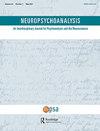是与否的神经心理学
Q3 Psychology
引用次数: 1
摘要
在他的文章《神经生物学新发展对精神分析对象关系的一些启示》中,Kernberg(2021)将神经生物学见解应用于精神分析驱动理论,将其置于从生物学到心理学的人类动机的连续体中。鉴于最近对情感大脑系统的神经科学发现,他重新审视和修正了双重驱动和动态无意识思维形成的精神分析理论——特别是通过克莱因客体关系理论的公式来考虑(克莱因,1946)。本文的主要论文将情感大脑系统及其在客体关系矩阵中的表达赋予了主要的动机作用。这篇评论发现(1)与主要论文的表述完全一致,但(2)不同意其更广泛的前提,即与驱动力概念有关的前提。本文章由计算机程序翻译,如有差异,请以英文原文为准。
The neuropsychobiology of yes and no
In his article “Some Implications of New Developments in Neurobiology for Psychoanalytic Object Relations,” Kernberg (2021) applies neurobiological insights to psychoanalytic drive theory, placing it within the continuum of human motivation from biology to psychology. He revisits and revises the psychoanalytic theory of dual drives and the formation of the dynamic unconscious mind in view of the recent neuroscientific findings of affective brain systems – particularly considered through the formulations of Kleinian object relations theory (Klein, 1946). The main thesis of the article assigns a primary motivational role to the affective brain systems and their expression within the matrix of object relations. This commentary finds (1) emphatic agreement with the formulations of the main thesis but (2) disagreement with its wider premises, namely those related to the concept of the drives.
求助全文
通过发布文献求助,成功后即可免费获取论文全文。
去求助
来源期刊

Neuropsychoanalysis
Psychology-Neuropsychology and Physiological Psychology
CiteScore
2.50
自引率
0.00%
发文量
24
 求助内容:
求助内容: 应助结果提醒方式:
应助结果提醒方式:


